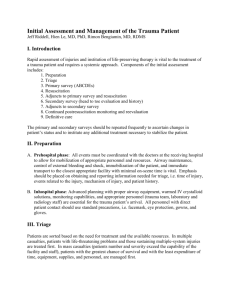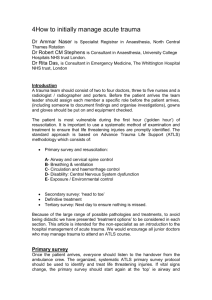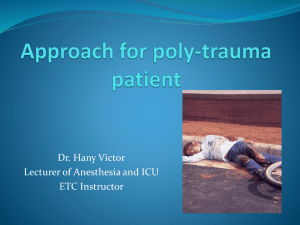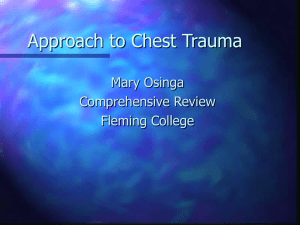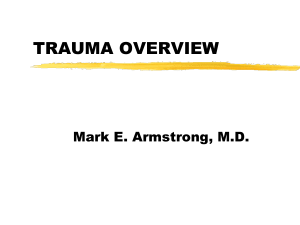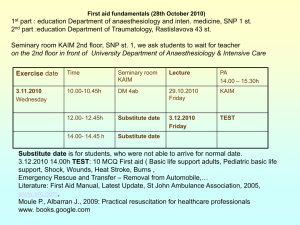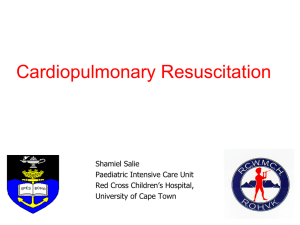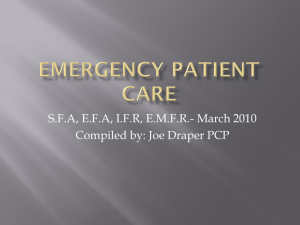new Initial management in trauma
advertisement
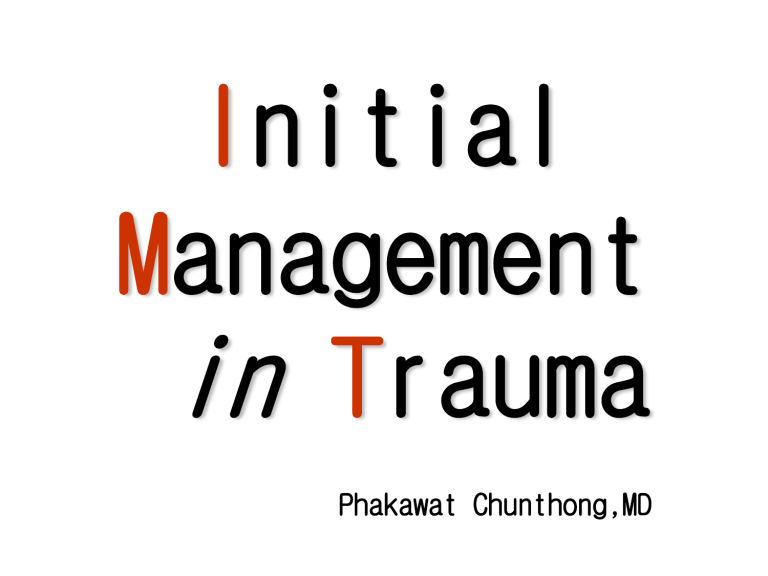
Initial Management in Trauma Phakawat Chunthong,MD Trimodal distribution of death Timing of Death Resulting from Trauma The first peak • 50% • Death at the time of injury • Primary injury to major organs such as brain,heart,great vessels • The injuries are irrecoverable, rapid treatment and transfer may salvage some patients • Primary prevention Timing of Death Resulting from Trauma The second peak • 30% • From the end of the first peak to several hours • GOLDEN HOUR • Morbidity and mortality are prevented by avoidance of a secondary injury due to hypoxia,hemorrhage,inadequate tissue perfusion • Intracranial hematoma,major hemorrhage from viscera,bones and vessels or hemothorax • ATLS [Advanced Trauma Life Support] 9% • Prehospital and in hospital Timing of Death Resulting from Trauma The third peak • • • • • 20% Death occurs days or weeks after the injury Sepsis and multiple organ failure Advances in intensive care reduce deaths Improvements in initial management on admission reduce morbidity and mortality ATLS guideline 1. preparation 2. triage 3. primary survey[ABCDE] 4. resuscitation 5. adjuncts to primary survey and resuscitation 6. secondary survey 7. adjuncts to secondary survey 8. continued post resuscitation monitoring and reevaluation 9. definitive care Preparation 1.Prehospital phase [EMS] • Notify receiving hospital • Airway maintenance, control of external bleeding and shock, immobilization of the patient 2.Inhospital phase • • • • Resuscitation area Equipment, monitor,warmed fluid Trauma team Protective communicable disease Cap Gown Gloves Mask Shoe Covers Goggles / face shield Triage Sorting of patients according to ABCDEs Available resources Multiple Mass Primary survey and resuscitation • identify immediately treatable life threatening injury with initial resuscitation • A airway maintenance with cervical spine control • B breathing and ventilation • C circulation and bleeding control • D disability:neurologic status • E exposure/environmental control:complete undress the patient but prevent hypothermia A airway maintenance with cervical spine control • Talk to the patient • Check the airway patency: secretion, blood, stridor • C-spine protection A airway maintenance with cervical spine control Basic airway management 1.remove of foreign material from mouth and pharynx 2.Chin lift and jaw thrust 3.Oropharyngeal or nasopharyngeal airway A airway maintenance with cervical spine control Definitive airway 1.orotracheal intubation 2.nasotracheal intubation 3.surgical airway 3.1 cricothyroidotomy 3.2 tracheostomy A airway maintenance with cervical spine control orotracheal intubation nasotracheal intubtion • ทำได ้ง่ำย เร็ว เกิด ้ ภำวะแทรกซอนน ้อย ทีส ่ ด ุ ั ว่ำ • ในผู ้ป่ วยทีม ่ ห ี รือสงสย มี cervical spine injury ให ้ทำ in-line stabilization ่ ำก ต ้องใช ้ • ใสย ประสบกำรณ์ • ผู ้ป่ วยต ้องหำยใจเองได ้ • ไม่ควรใสใ่ นผู ้ป่ วยทีม ่ ี กระดูกหน ้ำหัก A airway maintenance with cervical spine control A airway maintenance with cervical spine control surgical airway • failure endotracheal intubation • maxillofacial injury,blunt or penetrating neck injury ทีท ่ ำให ้ไม่สำมำรถ intubate ได ้ ตำมปกติ • Cricothyroidotomy 1.Needle cricothyroidotomy 2.Surgical cricothyroidotomy • Tracheostomy A airway maintenance with cervical spine control 1.Needle cricothyroidotomy 2.Surgical cricothyroidotomy A airway maintenance with cervical spine control C-spine protection • • • • unconscious GCS 8 Neck pain Quadriplegia, paraplegia, hemiplegia B breathing and ventilation • • • • • • • Respiration Chest movement RR Tracheal position Breath sound Subcutaneous emphysema Inspection of neck vein and wound B breathing and ventilation • Tension pneumothorax • Flail chest • Open chest wound • Massive hemothorax Tension pneumothorax Tension pneumothorax • Chest pain • Air hunger • Respiratory distress • Tachycardia • hypotension • Tracheal deviation • Unilateral absence of breath sound • Neck vein distention • Cyanosis Tension pneumothorax Tension pneumothorax Management • Immediate decompression: needle thoracocentesis (Rapidly inserting a large-bore needle into the 2nd intercostal space , midclavicular line of the affected side) • Definitive treatment: chest tube Flail chest • กระดูกซโี่ ครงหัก 2 ตำแหน่งใน 1 ซเี่ ป็ นจำนวน 3 ซ ี่ ขึน ้ ไปทีอ ่ ยูต ่ ำแหน่งติดกัน หรือ มีกระดูกซโี่ ครงหัก อย่ำงน ้อย1 ซรี่ ว่ มกับมี costochondral separation หรือ fracture ของ sternum • lung contusion,pneumothorax,hemothorax • paradoxical respiration • กำรรักษำจะมุง่ แก ้ไขภำวะ hypoventilation (จำก pain)และ hypoxia(จำก pulmonary contusion หรือ hemo-pneumothorax) Flail chest Flail chest Open chest wound • “sucking chest wound” • บำดแผลของผนังทรวงอกขนำดใหญ่กว่ำ 2/3 ของ ้ ำศูนย์กลำงของ trachea เสนผ่ ่ อ ่ งอก ทำให ้เกิด • เมือ ่ หำยใจเข ้ำลมภำยนอกจะเข ้ำสูช respiratory distress • กำรรักษำทำโดยปิ ดบำดแผลด ้วย sterile occlusive dressing ปิ ด plaster ไว ้ 3 ด ้ำน • ใส่ chest tube เย็บปิ ดบำดแผลในห ้องผ่ำตัด • ถ ้ำมีปัญหำกำรหำยใจมำก ควรใส่ endotracheal tube และชว่ ยหำยใจ Open chest wound Open chest wound Massive hemothorax ่ งปอดมำกกว่ำ 1,500 ml • ภำวะทีม ่ เี ลือดออกในชอ • อำจมีอำกำรคล ้ำยกับ tension pneumothorax • กำรรักษำทำโดยกำรใส่ chest drain และ fluid resuscitation indication for thoracotomy • เวลำทีไ่ ด ้รับบำดเจ็บไม่นำนและเลือดออกจำก chest tube มำกกว่ำ 1,500 ml • เลือดออกจำก chest tube มำกกว่ำชวั่ โมงละ 100200 ml. เป็ นเวลำหลำยชวั่ โมง (4-6 ชม.) Massive hemothorax C circulation and bleeding control • • • • BP, PR, LOC Skin color, capillary refill External bleeding site Internal bleeding site: thorax, abdomen, pelvis, extremities Class 1 Class 2 Class 3 Class 4 Blood loss (ml) 750 750-1,500 1,500-2,000 > 2,000 Blood loss (% ) 15 15-30 30-40 >40 <100 >100 >120 >140 normal normal Capillary refill normal Slow (>2s) Slow (>2s) undetectable RR 14-20 20-30 30-40 >35 Urine output(ml/hr) >30 20-30 5-15 negligible Mental status slightly anxious mildly anxious anxious/confused confused/ lethargic crystalloid crystalloid crystalloid plus blood Crystalloid plus blood Pulse BP Pulse pressure Fluid replacement C circulation and bleeding control • Warmed Balnced salt solution • 2 large bore • 2 liters in 10-15 mins, child bolus 20 ml/kg • G/M C circulation and bleeding control • Hemorrhagic shock • Cardiogenic shock • neurogenic shock Hemorrhagic shock Initial fluid therapy • ในผู ้ใหญ่ทม ี่ ี hypotension สำมำรถให ้ bolus ปริมำตร 2 ลิตร ภำยใน 10-15 นำที ในเด็กให ้ bolus 20 ml/kg 1.Rapid response 2.Transient response 3.Minimal or no response Hemorrhagic shock Rapid response • หลังให ้สำรน้ ำไปแล ้วในตอนแรก ผู ้ป่ วยจะมี ี จรและปริมำณปั สสำวะ ควำมดันโลหิต ชพ กลับมำเป็ นปกติ ้ • ลด fluid ลงมำชำๆเพื อ ่ maintenance ี เลือดน ้อยกว่ำ 20% • เสย Hemorrhagic shock Transient response • หลังจำกได ้ initial fluid bolus แล ้วมี อำกำรดีขน ึ้ ชวั่ ครำว เทือ ่ ลดปริมำณ fluid ทีใ่ ห ้ ลงกลับมีอำกำรแย่ลงอีก • จำเป็ นต ้องให ้ fluid ต่อไปและควรให ้เลือด ี เลือด 20-40% • เสย • ผู ้ป่ วยกลุม ่ นีถ ้ ้ำยังมีเลือดออกต ้องผ่ำตัดห ้ำม เลือด Hemorrhagic shock Minimal or no response • ผู ้ป่ วยไม่ตอบสนองต่อ fluid หรือเลือดเลย มี ควำมดันโลหิตตำ่ ตลอด • ต ้องจำเป็ นผ่ำตัดแก ้ไขและห ้ำมเลือดโดยด่วน ่ pump • แต่ต ้องระมัดระวังจำกสำเหตุอน ื่ เชน failure จำก cardiac injury หรือ cardiac tamponade • ต ้องทำ CVP,EKG Cardiogenic shock • Myocardial dysfunction อำจจะเกิดจำก tension pneumothorax, myocardial contusion, cardiac tamponade, air embolism, myocardial infarction • Cardiac tamponade มักเกิดจำก penetrating injury ผู ้ป่ วยจะมี Beck’s triad คือ venous pressure elevation, hypotension, distance heart sound ซงึ่ อำกำรคล ้ำยกับ tension pneumothorax • myocardial contusion พบใน blunt chest ่ หน ้ำอกกระแทกพวงมำลัย injury เชน Cardiogenic shock neurogenic shock • มีสำเหตุจำก spinal cord injury ระดับ mid thoracic ขึน ้ ไป • ไม่ได ้เกิดจำก head injury ถ ้ำมีมักเป็ น hypovolemic shock หรือ severe brain injury • ผู ้ป่ วย loss symphathetic tone เกิด vasodilatation neurogenic shock • ผู ้ป่ วยจะมี hypotension แต่ heart rate ไม่ เร็ว • initial treatment ยังเป็ น fluid resuscitation ถ ้ำให ้ adequate resuscitation แล ้วแต่ยังมี hypotension ควรพิจำรณำให ้ vasopressor drug • ต ้องมี CVP monitoring เพือ ่ ชว่ ยปรับปริมำณ กำรให ้ fluid resuscitation D disability:neurologic status • GCS • Pupils size and light reaction GLASGOW COMA SCALE Variables Eye opening Verbal response Best motor response Score Spontaneous To speech To pain None Oriented Confused conversation Inappropriate words Incomprehensible sounds None Obeys commands Localizes pain Normal flexion Abnormal flexion Extension None 4 3 2 1 5 4 3 2 1 6 5 4 3 2 1 E exposure/environmental control • • • • Undressed Exam back region All entry and exit wound Prevent hypothermia(warming light, warm blankets, warm resuscitation fluid, warm inspired air) • Patient’s right, closed area adjuncts to primary survey and resuscitation • • • • • • • Vital signs ECG O2 sat,pulse oximeter Uinary and gastric catheter Urine out put Trauma film:lateral c-spine,CXR,pelvis DPL/FAST Primary survey and resuscitation • Protect and secure airway • Ventilate and oxygenate • Stop the bleeding! • Vigorous shock therapy • Protect from hypothermia secondary survey The complete history and physical examination Secondary survey • • • • • • History Physical exam: head to toe “tubes and fingers in every orifice” Complete neurological exam Special diagnosis tests reevaluation Secondary survey History “AMPLE” A:Allergies M:Medication currently being taken by the patient P:Past illness and operations,pregnancy L:Last meal E:Event/Environment related to the injury Secondary survey • Mechanism of injury Secondary survey HEAD • Signs of skull base fracture • Pupillary size • Hemorrhages of conjunctiva/fundi • Visual acuity • Penetrating injury • • • • • Contact lens Dislocation of lens Hyphaema Ocular movement Posterior scalp laceration Secondary survey MAXILLOFACIAL • Associated with airway obstruction or major bleeding • Fracture cribriform plate • No NG tube [performed oral route] Secondary survey NECK • Cervical tenderness, subcutaneous emphysema • Oesophageal injury • Tracheal/laryngeal injury • Carotid injury (penetrating/blunt) Secondary survey CHEST Inspect Palpate Percuss Auscultate Obtain x-rays Secondary survey ABDOMEN Inspect Auscultate Palpate Percuss Reevaluate Special studies Secondary survey • Perineum:contusion,hematoma, laceration,urethral blood • Rectum:sphincter tone,high riding prostate,pelvic fracture,rectal wall integrity,blood • Vagina:blood,laceration Secondary survey Musculoskeletal • Contusion, deformity • Pain • Perfusion • Peripheral neurovascular status • X-ray Secondary survey Neurologic: brain GCS Score Lateralizing signs Frequent reevaluation Prevent secondary brain injury Secondary survey Neurologic: spine and cord Complete motor and sensory exams Imaging as indicated Reflexes Adjuncts to secondary survey Special diagnostic tests as indicate • CT • Contrast x-ray studies • Extremity x-ray • Endoscopy • Ultrasound Monitoring and revaluation • Minimize missed injury • High index of suspicion • Adult urine output 0.5ml/kg/hr • Pediatric urine output 1ml/kg/hr • Pain relief -- IM should be avoid Definitive care • OR • ICU • Refer
